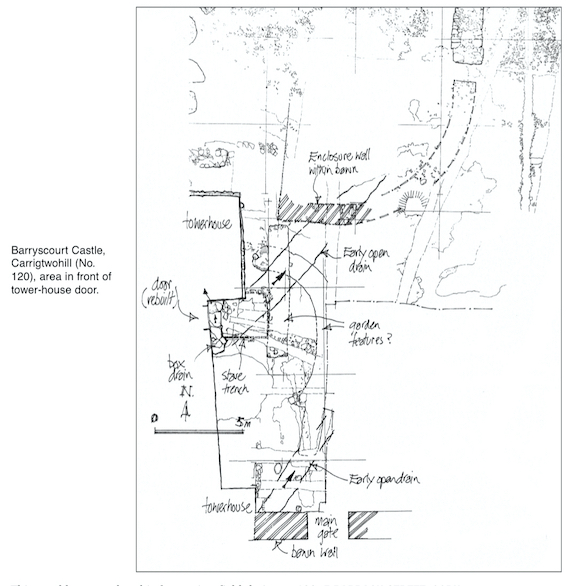County: Cork Site name: BARRYSCOURT CASTLE, Carrigtwohill
Sites and Monuments Record No.: N/A Licence number: 96E0238
Author: Dave Pollock
Site type: Castle - tower house and Bawn
Period/Dating: Multi-period
ITM: E 582177m, N 572521m
Latitude, Longitude (decimal degrees): 51.904558, -8.258999
A short season of excavations in 2000 at Barryscourt completed the recent campaign to investigate the bawn (Excavations 1999, 24–5). The unfinished area in front of the tower-house doorway was completed, and three small cuts were made outside the bawn to investigate the castle’s relationship with an infilled ditch and a standing enclosure wall.
The bawn appears to have been enclosed with the present wall in the late 16th century, when the tower-house door was rebuilt. Prior to this a pair of open drains (bridged or boarded over) carried water away from the ground in front of the tower-house door, towards the nearby stream.
The stone frame around the door was replaced, probably in the early 1580s. Immediately outside the new door, and underground, a box drain carried water into the building, probably from an open drain (not surviving) at the foot of the tower-house wall, to a basement room formerly used as a prison but converted (to a cistern).
A rectangular stave structure outside the new door may have been a platform or porch. A wide linear feature beyond, filled with rubble and mortar but not associated with a robbed wall, was probably a garden bed and preceded a similar feature cut in an arc concentric to the doorway. (A number of garden features have been identified in the enclosed north-west corner of the bawn in recent years.)
An early ditch was investigated on the west side of the tower-house. The excavation clearly showed the ditch to pre-date the tower-house and to have been deliberately infilled during construction. The ditch and associated bank were probably an earlier land division and drain.
This year dendrochronological samples wrought havoc with the late dating at Barryscourt. While the tower-house and bawn wall are undoubtedly late medieval, a felling estimate of AD 1197±9 years (Q10025) from the base of a sluice-gate and felling estimates of AD 616±9 and AD 633±9 years (Q10026, Q10027) from a ‘fish trap’ in the stream on site have provoked a reappraisal. The ‘fish trap’ is easily rehabilitated as the truncated remains of a 7th-century horizontal mill, but the sluice-gate suggests activity beside the stream at the start of the 13th century. The second mortared stone building on site, beside the sluice, may considerably pre-date the tower-house. The possibility of continuous occupation of the site from the start of the 13th century is currently being debated.

Knockrower Road, Stradbally, Co. Waterford